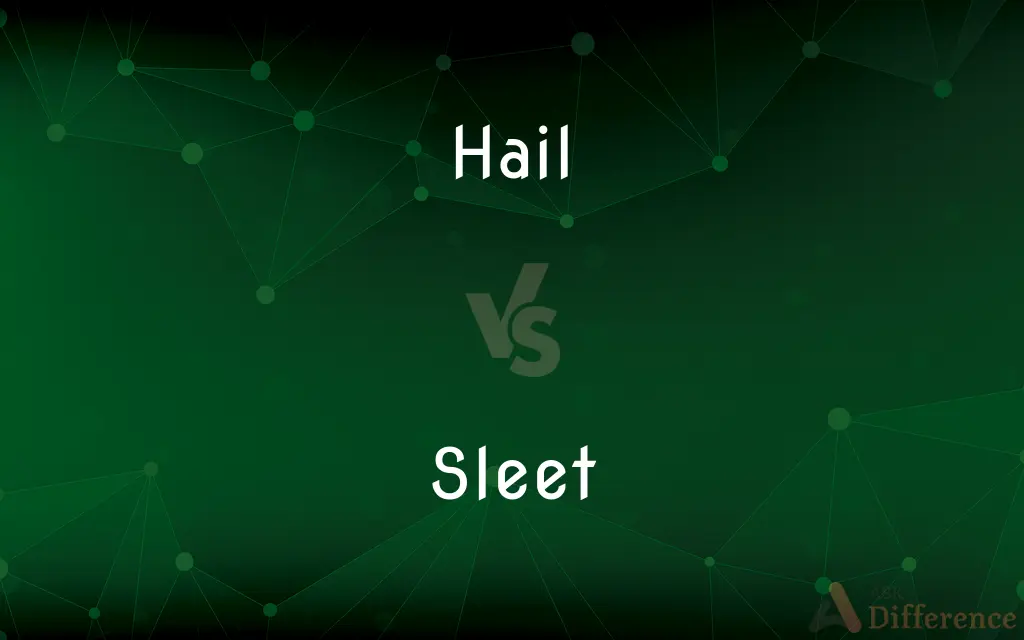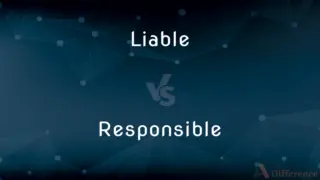Hail vs. Sleet — What's the Difference?
By Tayyaba Rehman — Updated on November 3, 2023
Hail is precipitation of ice balls; sleet is a mix of rain and snow. Hail forms in storms, sleet in winter weather.

Difference Between Hail and Sleet
Table of Contents
ADVERTISEMENT
Key Differences
Hail is a type of precipitation that consists of balls or irregular lumps of ice, known as hailstones, and is usually associated with thunderstorms. Sleet, on the other hand, is a form of winter precipitation that occurs when raindrops freeze into ice pellets before they hit the ground. Hailstones are formed by layers of water freezing on a nucleus in a strong updraft and can grow quite large.
Sleet is smaller and occurs when snowflakes melt partially while falling through a warm layer of air, then refreeze into pellets as they pass through a subfreezing layer closer to the Earth's surface. Hail is more common during spring and summer months, whereas sleet is associated with winter weather conditions. Sleet can make roads slippery, but hail can cause significant damage to crops, vehicles, and buildings.
While both hail and sleet are icy precipitation, hail is produced by intense thunderstorms where there are strong updrafts, and sleet is produced by more typical winter storm conditions. Hailstones, often measuring between 5 mm and 15 cm in diameter, are significantly larger than sleet pellets, which are typically the size of a pea or smaller. Hail can cause injury or damage due to its size and the speed at which it falls.
Sleet is generally less destructive than hail and is characterized by a slushy accumulation that resembles small, translucent balls of ice. Hail is quite distinct in its formation process, involving multiple trips up and down within a storm cloud, accumulating layers of ice. In contrast, sleet forms during a single journey from the cloud to the ground, involving both freezing and partial melting.
In summary, hail and sleet are two different forms of precipitation that differ in their development, size, and potential impact. Hail is related to strong storm activity and can be destructive due to the size of the hailstones, while sleet is a winter phenomenon that results from layered temperature variations in the atmosphere and usually has less impact in terms of damage.
ADVERTISEMENT
Comparison Chart
Formation
Forms in thunderstorms with strong updrafts
Forms in winter storms with warm layers
Size
Ranges from pea-sized to golf ball-sized
Small, ice pellets, pea-sized or smaller
Temperature Conditions
Requires a mix of warm and cold layers aloft
Occurs in subfreezing temperatures at ground level
Seasonality
Common in warmer seasons (spring/summer)
Associated with cold seasons (fall/winter)
Impact
Can cause significant damage and injury
Causes hazardous driving conditions
Compare with Definitions
Hail
Hard, frozen rain that can cause damage.
Cars were dented from the intense hail we had.
Sleet
Frozen raindrops that turn into ice pellets.
Sleet made the morning commute treacherous.
Hail
Layered ice spheres created in strong updrafts.
Hail accumulated quickly, covering the driveway.
Sleet
Small ice particles from partially melted snowflakes.
The sleet clinked against the windows as it fell.
Hail
Cold weather phenomenon associated with storms.
We watched the hail from indoors, listening to it drum on the roof.
Sleet
A form of icy precipitation causing slippery surfaces.
School was delayed due to the overnight sleet.
Hail
Hail is a form of solid precipitation. It is distinct from ice pellets (American English "sleet"), though the two are often confused.
Sleet
Precipitation consisting of small ice pellets formed by the freezing of raindrops or of melted snowflakes.
Hail
Precipitation in the form of spherical or irregular pellets of ice larger than 5 millimeters (0.2 inch) in diameter, usually associated with thunderstorms.
Sleet
A mixture of rain and snow or hail.
Hail
Something that falls with the force and quantity of a shower of ice and hard snow
A hail of pebbles.
A hail of criticism.
Sleet
A thin icy coating that forms when rain or sleet freezes, as on trees or streets.
Hail
The act of greeting or acclaiming.
Sleet
To shower sleet.
Hail
A shout made to catch someone's attention or to greet.
Sleet
Pellets of ice made of mostly frozen raindrops or refrozen melted snowflakes.
Hail
Hailing distance
Told me to stay within hail.
Sleet
Precipitation in the form of a mixture of rain and snow.
Hail
To precipitate in pellets of ice and hard snow.
Sleet
(rare) A smooth coating of ice formed on ground or other objects by freezing rain.
Hail
To fall like hailstones
Condemnations hailed down on them.
Sleet
(firearms) Part of a mortar extending from the chamber to the trunnions.
Hail
To pour (something) down or forth
They hailed insults at me.
Sleet
To be in a state in which sleet is falling.
I won't bother going out until it's stopped sleeting.
Hail
To salute or greet.
Sleet
The part of a mortar extending from the chamber to the trunnions.
Hail
To greet or acclaim enthusiastically
The crowds hailed the boxing champion.
Sleet
Hail or snow, mingled with rain, usually falling, or driven by the wind, in fine particles.
Hail
To call out or yell in order to catch the attention of
Hail a cabdriver.
Sleet
To snow or hail with a mixture of rain.
Hail
To signal or call to a passing ship as a greeting or identification.
Sleet
Partially melted snow (or a mixture of rain and snow)
Hail
Used to express a greeting or tribute.
Sleet
Precipitate as a mixture of rain and snow;
If the temperature rises above freezing, it will probably sleet
Hail
S or pieces of ice falling as precipitation, often in connection with a thunderstorm.
Sleet
Winter precipitation that is a mix of rain and snow.
The forecast predicts snow turning to sleet by evening.
Hail
An occurrence of this type of precipitation; a hailstorm.
Sleet
Translucent ice pellets from freezing rain.
The sidewalks were slippery with a layer of sleet.
Hail
A rapid, intense barrage by a large number of projectiles or other objects.
Hail
(impersonal) Of hail, to fall from the sky.
They say it's going to hail tomorrow.
Hail
(intransitive) To send or release hail.
The cloud would hail down furiously within a few minutes.
Hail
To pour down in rapid succession.
Hail
(transitive) To greet; give salutation to; salute.
Hail
(transitive) To name; to designate; to call.
He was hailed as a hero.
Hail
(transitive) To call out loudly in order to gain the attention of.
Hail a taxi.
Hail
To indicate, from a designated stop or otherwise, to the driver of a public transport vehicle that one wishes to board and travel on the vehicle, usually using hand signals such as waving.
In Melbourne, you would usually have to hail a tram when you are travelling late at night and there are no other passengers waiting at your stop.
Hail
(transitive) To signal in order to initiate communication with.
Hail
(obsolete) Healthy, whole, safe.
Hail
An exclamation of respectful or reverent salutation, or, occasionally, of familiar greeting.
Hail
Small roundish masses of ice precipitated from the clouds, where they are formed by the congelation of vapor. The separate masses or grains are called hailstones.
Thunder mixed with hail,Hail mixed with fire, must rend the Egyptian sky.
Hail
A wish of health; a salutation; a loud call.
The angel hail bestowed.
Hail
To pour down particles of ice, or frozen vapors.
Hail
To pour forcibly down, as hail.
Hail
To call loudly to, or after; to accost; to salute; to address.
Hail
To name; to designate; to call.
And such a son as all men hailed me happy.
Hail
To declare, by hailing, the port from which a vessel sails or where she is registered; hence, to sail; to come; - used with from; as, the steamer hails from New York.
Hail
To report as one's home or the place from whence one comes; to come; - with from.
Hail
Healthy. See Hale (the preferable spelling).
Hail
An exclamation of respectful or reverent salutation, or, occasionally, of familiar greeting.
Hail
Precipitation of ice pellets when there are strong rising air currents
Hail
Enthusiastic greeting
Hail
Praise vociferously;
The critics hailed the young pianist as a new Rubinstein
Hail
Be a native of;
She hails from Kalamazoo
Hail
Call for;
Hail a cab
Hail
Greet enthusiastically or joyfully
Hail
Precipitate as small ice particles;
It hailed for an hour
Hail
Precipitation of small to large balls of ice.
The hail pelted against the windows during the storm.
Hail
Ice particles that fall during thunderstorms.
The garden was ruined after the hail storm last night.
Common Curiosities
What size can hailstones reach?
Hailstones can range from pea-sized to larger than a grapefruit.
Is sleet just frozen rain?
Sleet is similar to frozen rain but has a distinct process of partial melting and refreezing.
Are hail and sleet dangerous to drive in?
Yes, both can create hazardous driving conditions, but hail is also a physical danger due to its size.
Can hail occur in winter?
While less common, hail can occur in winter if thunderstorm conditions are present.
What safety precautions should be taken for hail?
Seek shelter indoors and protect vehicles if possible when hail is expected.
Can hail damage aircraft?
Yes, hail can cause severe damage to aircraft if encountered during flight.
What season is sleet most common?
Sleet is most common in late fall and winter.
How are hailstones formed?
Hailstones form in thunderstorms with strong updrafts that repeatedly lift the stones, allowing layers of ice to accumulate.
What conditions lead to sleet?
Sleet occurs when snowflakes partially melt then refreeze into pellets before reaching the ground.
Does hail form before it hits the ground?
Yes, hail forms completely in the cloud before falling to the ground.
Does sleet accumulate like snow?
Sleet can accumulate but typically forms a slushy or icy layer, unlike fluffy snow.
Is sleet a type of freezing rain?
Sleet is similar but consists of solid pellets, while freezing rain freezes on contact with surfaces.
What makes sleet different from hail?
Sleet forms from melted snowflakes that refreeze, whereas hail forms from droplets in strong updrafts in clouds.
How do hail and sleet affect crops?
Hail can destroy crops, while sleet has less impact but can still damage delicate plants.
Can sleet be predicted?
Yes, meteorologists can predict sleet by analyzing temperature profiles in the atmosphere.
Share Your Discovery

Previous Comparison
Whereas vs. Wherein
Next Comparison
Liable vs. ResponsibleAuthor Spotlight
Written by
Tayyaba RehmanTayyaba Rehman is a distinguished writer, currently serving as a primary contributor to askdifference.com. As a researcher in semantics and etymology, Tayyaba's passion for the complexity of languages and their distinctions has found a perfect home on the platform. Tayyaba delves into the intricacies of language, distinguishing between commonly confused words and phrases, thereby providing clarity for readers worldwide.
















































